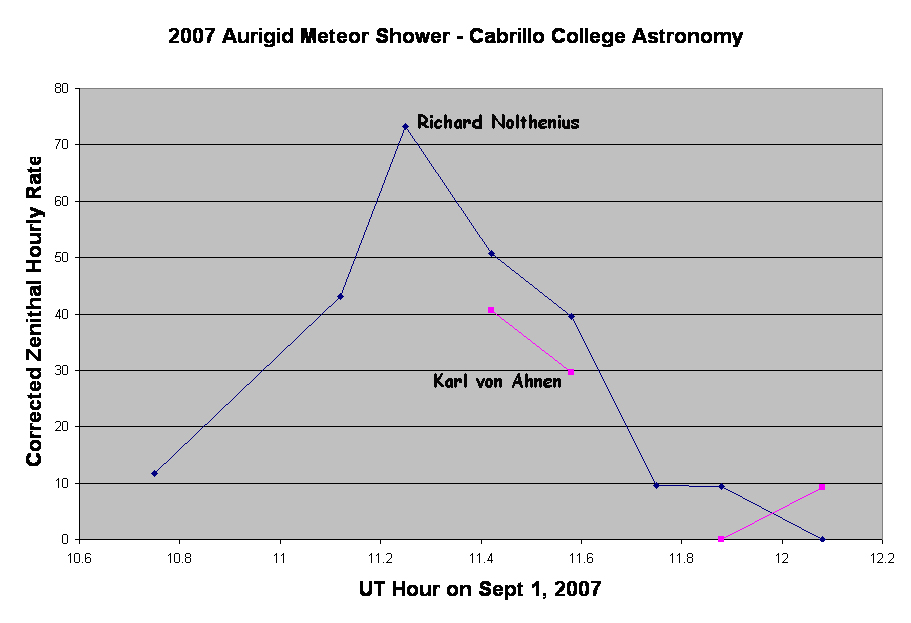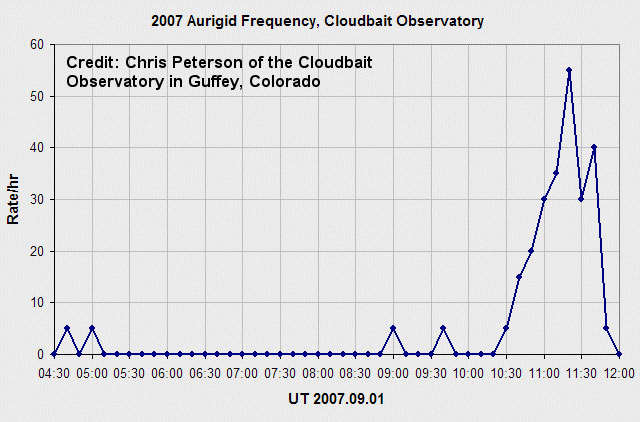
Sept 1, 2007
The Aurigids have on rare occasions put on a good show, and this year we passed centrally through the debris from long period comet Keiss. Some calculations called for rates of 200-1000 per hour. Enough to get us excited and ready to photograph. We had a good turnout. But just like last week's total lunar eclipse, location communication wasn't quite up to snuff. This time it was all my fault. Turns out the spot I've been using as "Highland Way turnout" for years is actually one ridge over from the spot I referenced on the topozone.com map. So we ended up once again with two groups. The "A" team was me, Karl, Jay and family, and Shahram. And the "B" Team ended up at the topozone.com "x" spot: Chris Angelos, Kirk Bender, and Eric. Chris Kitting stayed at home and photographed. I arrived at 3:10am and set up the GM8 mount for people to use for guided shots, and then layed out to do counts. Jay arrived next, with family, all excited about seeing the "storm". Then Sharahm, and after 4am Karl (much sleep deprived w/ stuff at the new Planetarium and conversations with Joel Primack on rendering the early Universe.) arrived to just set up a lawn chair and do counts.. My view of the sky was good, but some trees occulted around the edges, and I wore my trademark "Route 66" billed cap to block the moon from my eyes. Because of these obstructions, I have applied a geometric factor of 1.27 to all my and Karl's counts. Jay set up a PC164c with f/1.4 lens which showed as much as a typical observer would see, and easily got 3rd magnitude stars on his footage. I look forward to all of his images. He definitely got a few Aurigids, At site B, Kirk Bender also got one very bright Aurigid at 5:02am on his digital camera. I'll post it when he sends it to me.
I've used my program METEOR.EXE to convert our raw counts (bins of 10 minutes) into ZHR values and plot them using Excel. My wakefulness was good too! No nodding off. The moon was a problem of course, but kept just out of view above/behind me as I faced northwest. Our location was 37.07684 deg, -121.88265deg, 1908 ft elevation. Weather was in the high 70's (pre-dawn!) and very dry and clear. Perfect! The table below shows the raw counts, and the chart the ZHR counts after applying the 1.27 factor to account for trees/horizon obscuration.
10:40-10:50 UT |
11:00-11:10 UT |
11:10-11:20 UT |
11:20-11:30 UT |
11:30-11:40UT |
11:40-11:50 UT |
11:50-12:00 UT |
12:00-12:10UT |
|||||||||
| Richard Nolthenius | 1 |
2 |
4 |
1 |
7 |
2 |
5 |
2 |
4 |
5 |
1 |
3 |
1 |
0 |
0 |
2 |
| Karl von Ahnen | 4 |
0 |
3 |
1 |
0 |
0 |
1 |
3 |
||||||||
The Cloudbait Observatory impression, the Jenniskens site accounting, and my own all give the same impression - Aurigids were showing up as soon as I was awake and had my eye at all on the sky, before being ready for "official" counts, and that the counts dropped quite sharply at about 4:35am PDT. The peak was early and sharply cut off. Also, the pre-peak and peak meteors were mostly bright. Most were 1st magnitude or brighter, with few dim ones. However, the dribble of post-peak meteors were mostly dim. Not enough counts to make any statistically significant conclusion, but with your greater data maybe you can say the same thing with more certainty. Some size sorting spatially, as seems to seen in other showers.

Compare our counts above with the counts compiled at Cloudbait Observatory in Colorado and published on Spaceweather.com. They're quite similar... Looks like Danielle Moser's meteoroid stream model was the more correct one - predicting an earlier peak and weaker shower.

And also compare with the rates seen by Peter Jennisken's research group aboard the NASA jet taking data high in the atmosphere
Chris Kitting saw 12 meteors (Aurigids and sporadics) between 10:40 and 11:30UT, while occupied with his photography.
Chris Kitting at home in Hayward:
Out of 150 pairs of 10-sec
(ISO 800 then 1600) shots with the 35mm f coverage at f/2.8 on the Nik
D200 on a timer, I only got half a meteor, alas (at 0359). I cropped
it to 1/16 of the medium-size, hi-qual jpg (1944x2896,) attached here,
with NO processing (as requested at Spaceweather.com). With my paired
RAW file, I eventually can get rid of the (edge) chromatic aberration,
and noise, with ~30% better resolution too. |
Chris Kitting stacked images from his Sony camcorder uncropped, full-res (but medium-jpged, 100KB) stack of those 04:04:35 meteor frames from my Sony HD Video. I used Histograms and Curves to darken the noisy background here. The stars shown on the picture at right will allow setting the image scale, exactly the same on the two frames.
|
Chris Kitting submits:
"Stack of the 65 HD niteshot frames, showing STARS for scale, which
I shot at 0432, after the meteors were taken in the std (color) mode.
(Same scale.) I darkened the noisy (CMOS, warm, green) backgound with
Curves. Full frame and full res here, but jpged for email. (Not jpged
on the CD I am mailing). All my shots were aimed and oriented the same,
near Aquarius, centered near RA~1 h Dec~ -20 deg, just west of the moon,
toward Pegasus. It was on a clock drive. North is straight left in frame.
East is down in the frame. Moon flair is visible in this full frame, intensified
image. Tiny specks of noise probably persist somewhat, but the ~dozen
good stars each are multiple pixels. |
It's Labor Day, and I just listened to "All Things Considered" on National Public Radio - they interviewed Peter Jenniskens on the shower, and also quoted me with my nice turn of phrase posted on Spaceweather.com ... "After the peak, they were dimmer and sparse, almost like someone just shut off the meteor spigot!". C7ool!
Check back later - I'll have many more photo's to post; both of meteors and also of our group and set up.